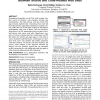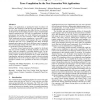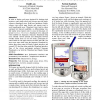770 search results - page 7 / 154 » Using web browser interactions to predict task |
CHI
2011
ACM
14 years 1 months ago
2011
ACM
Programmers frequently use the Web while writing code: they search for libraries, code examples, tutorials, and documentation. This link between code and visited Web pages remains...
VEE
2009
ACM
15 years 4 months ago
2009
ACM
Today’s web applications are pushing the limits of modern web browsers. The emergence of the browser as the platform of choice for rich client-side applications has shifted the ...
CHI
2009
ACM
15 years 10 months ago
2009
ACM
People regularly interact with different representations of Web pages. A person looking for new information may initially find a Web page represented as a short snippet rendered b...
CHI
2005
ACM
15 years 10 months ago
2005
ACM
In order to display web pages designed for desktop-sized monitors, some small-screen web browsers provide singlecolumn or thumbnail views. Both have limitations. Singlecolumn view...
104
click to vote
ICDM
2002
IEEE
15 years 2 months ago
2002
IEEE
We describe an efficient framework for Web personalization based on sequential and non-sequential pattern discovery from usage data. Our experimental results performed on real us...



